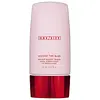What's inside
What's inside
 Key Ingredients
Key Ingredients

 Benefits
Benefits

 Concerns
Concerns

 Ingredients Side-by-side
Ingredients Side-by-side

Water
Skin ConditioningCyclopentasiloxane
EmollientPolymethylsilsesquioxane
Dimethicone
EmollientCeresin
Emulsion StabilisingGlycerin
HumectantSilica
AbrasiveCapryloyl Glycine
CleansingLauryl PEG-10 Tris(Trimethylsiloxy)Silylethyl Dimethicone
EmulsifyingTrimethylsiloxysilicate
EmollientPropylene Glycol
HumectantHdi/Trimethylol Hexyllactone Crosspolymer
Sodium Chloride
MaskingAminomethyl Propanol
BufferingHydrogenated Polyisobutene
EmollientDimethicone/PEG-10/15 Crosspolymer
Dimethicone Crosspolymer
Emulsion StabilisingKaolin
AbrasiveCharcoal Powder
AbrasiveDisodium EDTA
Triethoxycaprylylsilane
Alumina
AbrasiveOryza Sativa Bran Wax
Skin ConditioningPhenoxyethanol
PreservativeEthylhexylglycerin
Skin ConditioningCI 77891
Cosmetic ColorantWater, Cyclopentasiloxane, Polymethylsilsesquioxane, Dimethicone, Ceresin, Glycerin, Silica, Capryloyl Glycine, Lauryl PEG-10 Tris(Trimethylsiloxy)Silylethyl Dimethicone, Trimethylsiloxysilicate, Propylene Glycol, Hdi/Trimethylol Hexyllactone Crosspolymer, Sodium Chloride, Aminomethyl Propanol, Hydrogenated Polyisobutene, Dimethicone/PEG-10/15 Crosspolymer, Dimethicone Crosspolymer, Kaolin, Charcoal Powder, Disodium EDTA, Triethoxycaprylylsilane, Alumina, Oryza Sativa Bran Wax, Phenoxyethanol, Ethylhexylglycerin, CI 77891
Water
Skin ConditioningPolysilicone-11
Propanediol
SolventSilica
AbrasiveDimethicone
EmollientC15-19 Alkane
SolventDicaprylyl Carbonate
EmollientDimethicone/Vinyl Dimethicone Crosspolymer
Skin ConditioningGlycerin
HumectantGlyceryl Stearate Citrate
EmollientNiacinamide
SmoothingSodium Polyacrylate
AbsorbentHamamelis Virginiana Water
AstringentPhenoxyethanol
PreservativePvp
Emulsion StabilisingPullulan
Hydroxyacetophenone
AntioxidantLaureth-12
EmulsifyingEthylhexylglycerin
Skin ConditioningHdi/Trimethylol Hexyllactone Crosspolymer
Polymethylsilsesquioxane
Zingiber Officinale Root Extract
MaskingWater, Polysilicone-11, Propanediol, Silica, Dimethicone, C15-19 Alkane, Dicaprylyl Carbonate, Dimethicone/Vinyl Dimethicone Crosspolymer, Glycerin, Glyceryl Stearate Citrate, Niacinamide, Sodium Polyacrylate, Hamamelis Virginiana Water, Phenoxyethanol, Pvp, Pullulan, Hydroxyacetophenone, Laureth-12, Ethylhexylglycerin, Hdi/Trimethylol Hexyllactone Crosspolymer, Polymethylsilsesquioxane, Zingiber Officinale Root Extract
Ingredients Explained
These ingredients are found in both products.
Ingredients higher up in an ingredient list are typically present in a larger amount.
Dimethicone is a type of synthetic silicone created from natural materials such as quartz.
What it does:
Dimethicone comes in different viscosities:
Depending on the viscosity, dimethicone has different properties.
Ingredients lists don't always show which type is used, so we recommend reaching out to the brand if you have questions about the viscosity.
This ingredient is unlikely to cause irritation because it does not get absorbed into skin. However, people with silicone allergies should be careful about using this ingredient.
Note: Dimethicone may contribute to pilling. This is because it is not oil or water soluble, so pilling may occur when layered with products. When mixed with heavy oils in a formula, the outcome is also quite greasy.
Learn more about DimethiconeEthylhexylglycerin (we can't pronounce this either) is commonly used as a preservative and skin softener. It is derived from glyceryl.
You might see Ethylhexylglycerin often paired with other preservatives such as phenoxyethanol. Ethylhexylglycerin has been found to increase the effectiveness of these other preservatives.
Glycerin is already naturally found in your skin. It helps moisturize and protect your skin.
A study from 2016 found glycerin to be more effective as a humectant than AHAs and hyaluronic acid.
As a humectant, it helps the skin stay hydrated by pulling moisture to your skin. The low molecular weight of glycerin allows it to pull moisture into the deeper layers of your skin.
Hydrated skin improves your skin barrier; Your skin barrier helps protect against irritants and bacteria.
Glycerin has also been found to have antimicrobial and antiviral properties. Due to these properties, glycerin is often used in wound and burn treatments.
In cosmetics, glycerin is usually derived from plants such as soybean or palm. However, it can also be sourced from animals, such as tallow or animal fat.
This ingredient is organic, colorless, odorless, and non-toxic.
Glycerin is the name for this ingredient in American English. British English uses Glycerol/Glycerine.
Learn more about GlycerinThis ingredient is a powder used to improve texture, slip, and give products a silky texture.
Phenoxyethanol is a preservative that has germicide, antimicrobial, and aromatic properties. Studies show that phenoxyethanol can prevent microbial growth. By itself, it has a scent that is similar to that of a rose.
It's often used in formulations along with Caprylyl Glycol to preserve the shelf life of products.
Polymethylsilsesquioxane is a silicone used as a film forming agent.
When applied to the skin, this ingredient creates an invisible film on the surface. This film still allows oxygen to pass through, but prevents moisture from escaping. This can help condition and hydrate the skin. It also leaves a silky feel when applied.
Polymethylsilsesquioxane has not been shown to clog pores. It has been deemed safe to use up to 55%, but most cosmetics use much less.
If you have concerns about using this ingredient, we recommend speaking with a professional.
Learn more about PolymethylsilsesquioxaneSilica, also known as silicon dioxide, is a naturally occurring mineral. It is used as a fine, spherical, and porous powder in cosmetics.
Though it has exfoliant properties, the function of silica varies depending on the product.
The unique structure of silica enhances the spreadability and adds smoothness, making it a great texture enhancer.
It is also used as an active carrier, emulsifier, and mattifier due to its ability to absorb excess oil.
In some products, tiny microneedles called spicules are made from silica or hydrolyzed sponge. When you rub them in, they lightly polish away dead skin layers and enhance the penetration of active ingredients.
Learn more about SilicaWater. It's the most common cosmetic ingredient of all. You'll usually see it at the top of ingredient lists, meaning that it makes up the largest part of the product.
So why is it so popular? Water most often acts as a solvent - this means that it helps dissolve other ingredients into the formulation.
You'll also recognize water as that liquid we all need to stay alive. If you see this, drink a glass of water. Stay hydrated!
Learn more about Water